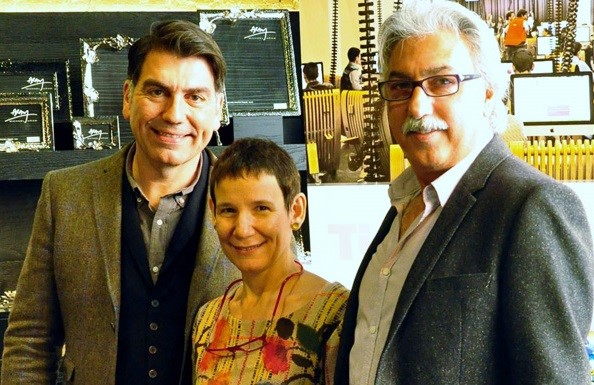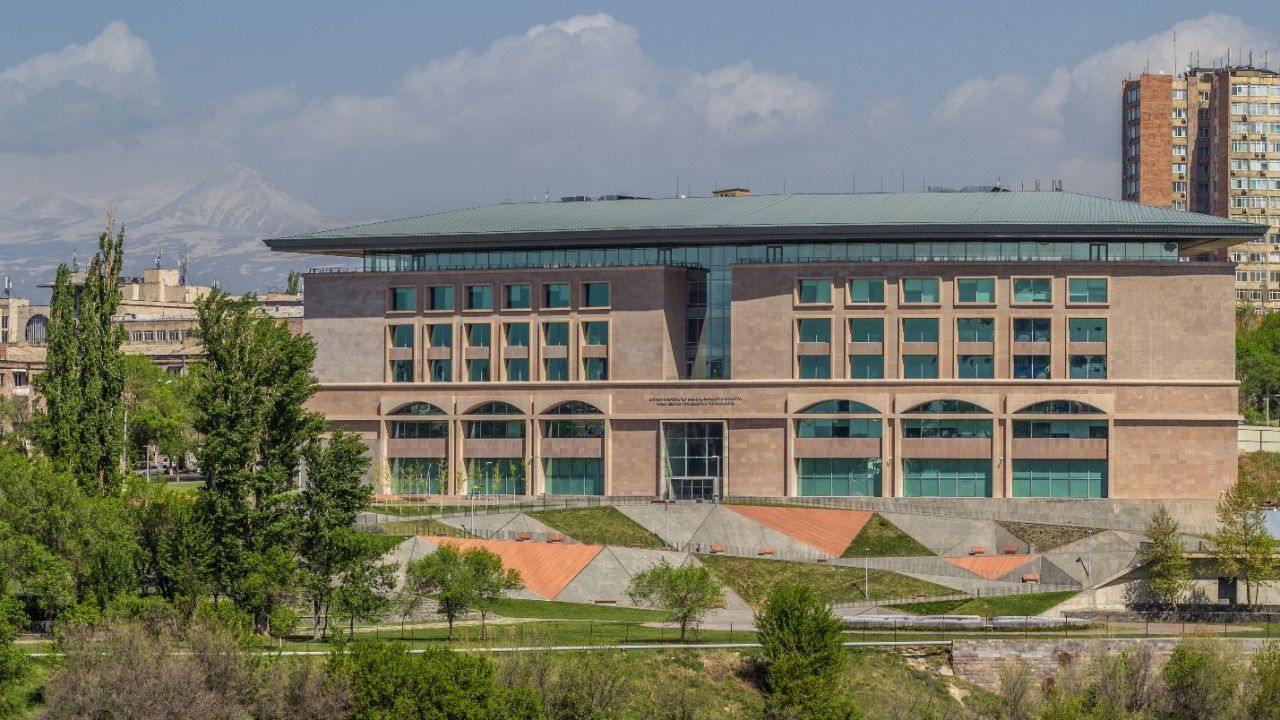 30
June
2022
30
June
2022
ISET Economist Blog
 Monday,
28
November,
2016
Monday,
28
November,
2016

Spending a big chunk of their precious summer vacation in Armenia was not exactly my kids’ dream. Their wish list included far more exotic destinations in Africa, the Far East, and Europe’s leading capitals – Vienna, Paris, or London. And, yet, it did not take too much convincing for them to go on a one-week trial at TUMO’s summer school for creativity in Yerevan. All I had to do was show a few pictures from TUMO’s website:

What was supposed to be a one-week trial turned into a four-week immersion into the world of photography, 3D modeling and animation (for Katia, 10), and robotics and programming (for Jan, 12). It also became an eye-opening experience for their parents, giving us a sense of how to organize learning in the 21st century, and how to use education as a lever long enough to move the world.
Everything at TUMO is marked with a very special touch of creativity.
This starts with TUMO’s futuristic architectural design, which immediately strikes – and inspires – anybody entering the building.
It continues with TUMO’s proprietary learning software (“Tumo World,” a game-style virtual environment that helps students navigate the curriculum) and pedagogical approach. The point is to allow thousands of teens (7,000 of them at any given time, to be more precise) to tailor an individual self-study program and follow it, at their own pace, with a bit of help from TUMO coaches. Some students, “tigers” in TUMO’s lingo, take a few subjects all the way to the top level. Others, the “butterflies,” do the first couple of levels of every subject – an experimental approach encouraged by TUMO. The program is enriched with special workshops led by industry pros, including visitors from all over the world.
A lot of creative thinking went into the highly unorthodox learning menu, self-described as “arts, tech, and everything in between.” The main four focus areas are animation, game development, film-making, and web design. However, one also has plenty of opportunities to veer into complementary skills, like 3D modeling, robotics, programming, and music. With such a wide range of choices and flexibility, the program allows thousands of “TUMOians” (aged 12-18) to forge their own, unique paths to success.
Finally, TUMO’s ingenious financial architecture is a great model of sustainable philanthropy - development assistance delivered with a fresh business perspective in mind.
 |
| From left to right: TUMO board member and artist Michael Aram, managing director of TUMO Marie-Lou Papazian, and founder of TUMO Sam Simonian |
TUMO is anything but your typical government or donor project. It has its intellectual and financial roots in the Armenian diaspora segment of the global tech and arts community. TUMO’s chief architect and founder, Sam Simonian, is a Dallas-based IT entrepreneur. A self-made man, Mr. Simonian was 19 when he emigrated in 1975 from war-torn Lebanon to the US. Armed with an electrical engineering degree from the University of Texas, he went on to design telecommunication equipment for the U.S. defense industry. In 1989, Sam and two fellow engineers resigned from their well-paying jobs to build their own dream – INET – with 18,000 dollars in start-up capital, a fax machine, and a 200 dollar piece of testing equipment.
While Sam Simonian is the founder and the main driving force behind TUMO’s concept and content, many others play a key role. Marie-Lou and Pegor Papazian joined early on to provide local leadership and oversee the Center’s development. Having known each other since their childhood in Lebanon, the Papazians came to Armenia with a ton of tech, project, and education management experience from all over the world. Marie-Lou designed and managed the construction of the Center’s interior and outdoor plaza. Pegor led a team that developed TUMO’s learning software. Both are intimately involved in TUMO’s current efforts to expand its reach beyond Yerevan and (soon) Armenia’s borders.
Finally, TUMO’s board is a rare combination of artistic, tech, and entrepreneurial talent, including: the Engineering Director at Uber's Advanced Technologies Center (and formerly Twitter's Vice President of Platform Engineering) Raffi Krikorian, film producer at Pixar Animation Studios Katherine Sarafian, System of a Down’s lead vocalist Serj Tankian, and former Vice President of Game Development at Disney Interactive Studios, and founder of Industrial Toys, Alex Seropian. A dream team, indeed.
Tumo’s flagship complex in Yerevan occupies about 6,000 m2 on the first two floors of a purpose-designed 6-story building in Tumanyan park (hence TUMO’s name). The building’s other four floors provide office space for technology and media companies that have the potential to become partners in Tumo’s educational mission. Sam and Sylva Simonian, the founders of TUMO, have invested more than 60 million US dollars since 2001 to build the infrastructure, develop TUMO’s programs, and operate them in Yerevan for the first five years. Yet, it is the rental income from commercial tenants that will ensure the sustainability of TUMO!

As Pegor Papazian has stated, building up TUMO’s tenant base took more than two years. Until the third year of the operation, the entire cost of running TUMO’s programs (about 2 million dollars/year, including headquarters and communication) had to be covered by the Simonian Educational Foundation. Today, however, there is very little leftover space in the building, and the thoroughly impressive list of tenants includes the Armenia-based development arms of mobile photo editor PicsArt, electronic design automation giant Mentor Graphics, producer of intuitive human interface solutions Synaptics, as well as VoIP technology pioneer Epygi.
Many of TUMO’s former students and coaches stay to work in the building. However, as the vast majority of them are too busy to come down to give master classes, the main synergies, according to Pegor Papazian, are psychological. Newcomers get inspired by seeing successful guys and their cool style.
The bold decision to make TUMO’s education absolutely free for all students, regardless of their family circumstances, represents a conscious choice by its Board. There is no philosophical reason to make education free for everybody; however, need screening would have placed a hefty administrative burden on TUMO’s administration while detracting from TUMO’s role as an engine of societal change.
TUMO’s Board, its founder, and its management must take a lot of pride in the fact that as early as next year, in 2017, TUMO’s revenues from space rental and summer camp training (TUMO’s only educational undertaking with a commercial twist) will reach over 2 million U.S. dollars, finally catching up with operational expenses, and effectively securing the future of the entire enterprise.
The opening of TUMO’s Yerevan center in 2011 turned out to be but the first step in the process of branching out to Armenia’s provincial towns. While the idea was always there, the initiative came from the National Bank of Armenia (NBA), which was building its new facility in Dilizhan and wanted to stimulate additional investment in the human capital of this once very popular resort town. TUMO responded to the challenge by offering its know-how, and the Dilizhan center opened in January 2013, with its operational costs covered by the NBA.
Catering to 200 kids from Dilizhan and adjacent villages, the NBA-financed center turned out to be too small from an operational efficiency perspective. This was taken into account when building the next two centers, in Gyumri (launched in September 2015, with a capacity of 2000 students) and Stepanakert (October 2015, up to 1000 students). Both centers were built thanks to a vigorous fundraising campaign (to cover start-up costs), and a commitment by the Armenian General Benevolent Union (AGBU) to participate in the initial investment and cover operating costs for the first 5 years.
“We now know how to deploy a new center”, explains Pegor. “Construction aside, it takes only 2-3 months.” The main challenge with a network of smaller centers is not deployment, but efficient management. With a collective capacity of 3,000 students, the three new centers cost half a million USD a year to run (about $13-15 per student per month, excluding fixed costs). One key issue for sustainability is the difficulty of replicating the real estate model outside of Yerevan due to the lack of commercial renters. As there is no short-term solution to this problem, donor and government funding would be required to bridge the gap. But over time, IT businesses will find it profitable to relocate or branch out to provincial locations, given the availability of well-trained staff. In other words, by producing qualified personnel, TUMO will be investing in its own future sustainability.
The second challenge concerns the need for staff rotation.
From a financial point of view, it is not possible (and there is no operational justification) to simultaneously run expensive workshops on all 14 TUMO subjects in all four locations. Thus, efficiency requires that workshop leaders be shared: each gets to spend eight months in Yerevan, and one month in each other location. In this way, all expensive experts are fully utilized, and smaller centers are only charged for one month of an expert’s time while keeping core staff costs to the bare minimum (a director and a handful of locally hired coaches). Accordingly, the number of full-time equivalent (FTE) workshop leaders in each center is commensurate with its size, ranging from seven in Yerevan to only two in Gyumri.
When attending TUMO’s summer camp with my kids, I watched Marie-Lou’s presentation about TUMO’s ambitious plans to open new branches and/or sell franchises not only in Armenia but also in Brazil, Egypt, Iran, and Lebanon. I was surprised and disappointed to hear that Georgia, Armenia’s immediate neighbor, was not on the list of immediate targets. TUMO’s intentions aside, I think it would make perfect sense for Georgia’s Minister of Education, Sandro Jejelava, to include TUMO in his next visit to Yerevan, and engage Sam Simonian and other TUMO stakeholders in a serious discussion of how this amazing initiative could serve as a true friendship bridge between our two countries.





